Flanges are essential components in piping systems, used to connect pipes, valves, and other equipment. They ensure a secure, leak-proof connection and play a vital role in maintaining the integrity of fluid or gas transport. A flange connection typically involves two flanged ends that are bolted or welded together, offering both strength and flexibility. This type of connection allows for easy disassembly when needed, making maintenance and repairs more manageable. In some cases, such as with sanitary flanges, a gasket is used to create a tight seal. Flanges come in various materials like carbon steel, stainless steel, and others, each suited for different environments and applications. This guide will explore the fundamentals of flanges, their importance, types, sizes, and much more. Flanges serve multiple critical functions in piping systems. They enable the seamless joining of pipes while ensuring a leak-free connection. Additionally, they provide a sealing surface to prevent fluid or gas from escaping. By distributing the load across bolts, flanges also contribute to the structural stability of pipelines. They help control and direct fluid flow by integrating with valves or other flow control devices. Flanges are widely used in industries such as manufacturing, petrochemicals, and plumbing, where reliable and safe connections are essential. Their ability to form strong, durable joints makes them an indispensable part of modern infrastructure. In any piping system, flanges are crucial for assembly and performance. They prevent leaks in high-pressure environments, allowing for the safe and efficient movement of fluids. Flanges are especially important in industrial settings where reliability is key. Their use enhances the efficiency and safety of various applications, making them a fundamental element in piping systems. Understanding the correct face types and materials is essential for proper function, especially in demanding environments like chemical processing or oil and gas industries. For example, stainless steel flanges offer excellent durability and resistance to corrosion, making them ideal for long-term use in harsh conditions. Adhering to industry standards such as ASME and ASTM ensures that the flanges meet quality and compatibility requirements, which is crucial for consistent performance and safety. There are many types of flanges, each designed for specific applications and environments. Standards set by organizations like the American Society of Mechanical Engineers (ASME) and the American Society for Testing and Materials (ASTM) help ensure consistency and reliability in piping systems. For hydraulic applications, flanges may follow SAE J518 or ISO 6162 standards. Understanding these variations is key to selecting the right flange for your project. Slip-on flanges are commonly used in piping systems due to their ease of installation and cost-effectiveness. These flanges are slid over the pipe end before being welded in place. They are ideal for applications where quick installation and lower material costs are priorities, as they do not require precise matching of pipe thickness. While suitable for a wide range of temperatures and pressures, slip-on flanges are less appropriate for high-pressure or high-temperature situations compared to weld neck flanges. Their lightweight design and simple alignment make them well-suited for moderate service conditions. Socket-weld flanges are typically used in smaller diameter, high-pressure piping systems. The pipe is inserted into a recessed area of the flange, known as the socket, and then welded. This design provides a strong, reliable connection and is particularly useful in applications requiring smooth fluid flow without turbulence. Commonly used in chemical, petrochemical, and steam systems, socket-weld flanges help reduce the risk of leakage. They are also easier to align and assemble, which can be beneficial during installation. Lap joint flanges are ideal for systems that require frequent disassembly and maintenance. They consist of two parts: a stub end and a flange. The stub end is welded to the pipe, while the flange fits over it. This design allows for rotation, simplifying bolt hole alignment—especially in complex or large piping systems. Lap joint flanges are cost-effective because only the stub end needs to match the pipe material, while the flange itself can be made from a less expensive material. They are often used in systems with lined or expensive pipes, where ease of access and maintenance is crucial. Weld neck flanges are widely used in high-pressure environments, such as in chemical plants, power generation facilities, and construction projects. They provide a strong, durable connection between pipes, valves, and other components. Available in several types, including standard long, extra long, integral, and nipoflange, they are designed for different applications—from low-pressure systems to heavy-duty installations. Their key advantage is a robust, leak-proof design that reduces stress on the system, making them ideal for high-pressure and high-temperature scenarios. Blind flanges are solid discs used to close off the end of a pipe. They are commonly used in water systems, chemical manufacturing, and construction to isolate sections of a pipeline. These flanges are essential for pressure testing and future pipeline extensions. They are available in various materials, including A36 steel and stainless steel, to suit different operational requirements. Installing a blind flange requires a clean and smooth pipe end, followed by bolting the flange in place for a secure seal. Sanitary flanges are specifically designed for use in the pharmaceutical, biotech, and food and beverage industries, where cleanliness and sterility are critical. These flanges allow for quick and easy assembly and disassembly, facilitating regular cleaning and maintenance. Their smooth, non-porous surfaces prevent contamination and bacterial buildup. Sanitary flanges must adhere to strict industry standards, such as those established by 3-A Sanitary Standards and ASME-BPE, to ensure product integrity and compliance with health regulations. Flanges are ring-shaped fittings used to connect pipes, valves, pumps, and other equipment in a piping system. They provide easy access for cleaning, inspection, or modification of the system. Choosing the right flange depends on several factors, including the size and type of pipes being connected, the pressure and temperature of the system, the fluid being transported, and the environmental conditions. When choosing between stainless steel and carbon steel, consider the operating environment and requirements. Stainless steel offers better corrosion resistance and is ideal for harsh, acidic, or chlorine-rich environments, but it’s more expensive. Carbon steel is stronger and more cost-effective, making it suitable for high-pressure applications and less corrosive environments. Also, consider factors like temperature tolerance, weldability, maintenance needs, and industry-specific standards when making your decision. The installation of steel or stainless steel flanges involves aligning the flanges on either end of the pipes, inserting the appropriate gasket between them, and securing the assembly with bolts. The exact process can vary depending on the flange type and the specific application. Flanges are essential in modern infrastructure, providing strong, leak-proof connections in piping systems across various industries. From slip-on and socket-weld to lap joint, weld neck, blind, and sanitary flanges, each type is designed for specific uses. Their versatility in materials ensures they can be adapted to different environments. This guide highlights the importance of understanding the unique features and proper use of each flange type, showcasing their critical role in ensuring the integrity, efficiency, and safety of global piping networks. Shop all flanges Denture Container,Retainer Box Case,False Teeth Holder,Denture Travel Case Ningbo Hinix Hardware Industry & Trade Co., Ltd , https://www.hinixpack.comA Comprehensive Guide to Flange Basics
Usage of Flanges

Flanges' Significance in Plumbing & Piping
Examining Flange Varieties: An In-Depth Look

1) Slip-On Flanges
2) Socket-Weld Flanges
3) Lap Joint Flanges
4) Weld Neck Flanges
5) Blind Flanges
6) Sanitary Flanges
Frequently Asked Questions
What are flanges?
How do I choose the right stainless steel flange for my application?
How are flanges installed?
Conclusion